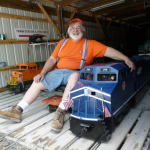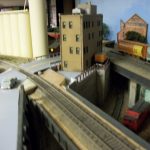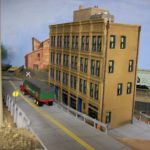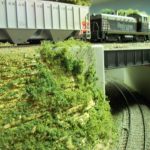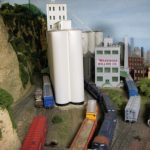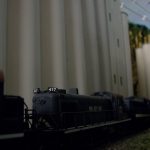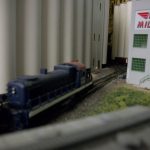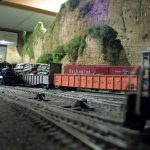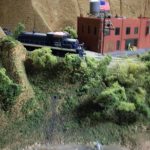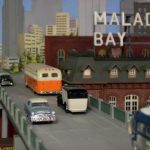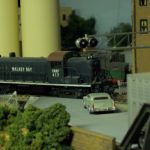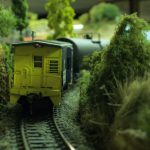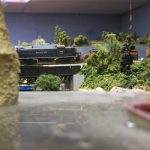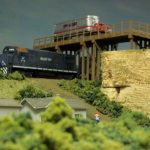Chicago, Malady Bay, and Pacific Railroad

Tom Maladecki’s Chicago, Malady Bay, and Pacific Railroad is a Midwest regional carrier. The primary CMBP mainline traverses Indiana and Illinois, extending into Iowa. The eastern terminus is Fort Wayne; the western terminus is Des Moines. Secondary lines extend into Michigan, Ohio, Wisconsin, and Missouri.
From its formation in the 1890s, the Malady Bay has been cooperatively owned and utilized by several Class 1 railroads. It interchanges with all of the railroads that enter Chicago, claiming a one to two day savings by bypassing Chicago rail congestion. The extensive interchange concept is similar to that of the Elgin, Joliet and Eastern; the Chicago, Milwaukee and Gary; or even the Illinois and St. Louis, or the Toledo, Peoria and Western.
The modeled section of the CMBP depicts the river bluff areas of northwest Illinois in the early 1970’s. Most Class 1 railroads sold their CMBP rights and the Malady Bay is now jointly guided by the recently formed Burlington Northern and Chessie System railroads. A lot of equipment lettered for BN and Chessie predecessor railroads is seen on the CMBP – – primarily CB&Q and B&O, but also GN, C&O, and NP; as well as WM and SP&S. In addition, the equipment of various interchange partners is seen – – like the Milwaukee Road and Rock Island. Newborn Amtrak runs a few trains in a circus of colors.
The Malady Bay relies primarily on diesel locomotives of the American Locomotive Company [ALCO]. Since ALCO terminated locomotive production in 1969, the Malady Bay has increased its information sharing with other railroads that remanufacture their ALCO locomotives. Therefore, diesels of the Detroit & Mackinac, the Green Bay and Western, and the Delaware & Hudson often visit the Malady Bay. Also, CMBP is actively acquiring used locomotives from railroads that are retiring their Alco’s.
The CMBP is in the RockRail “Display Railroads” category because of its emphasis on scenery, versus operations. I like to include a series of scenes for the viewer to enjoy. Industries are located throughout these scenes; however, there are no heavy concentrations of industrial sites. There are no local switch jobs along the way. Switching is done by local peddlerfreights en route. On the other hand, about 12 trains can be staged on the lower level, so several thru trains can be run in a session. This includes strictly bridge traffic as well as trains that would come into the yard for work. I enjoy operating the railroad alone, but it will support about five people – – a yard operator, a local job or two, a thru train or two, and a dispatcher/trouble shooter.
The 12’ x 35’ layout was built in three distinct “phases”. The original layout is a 6’ x 9’ folded, twisted dog bone that was started in 1976 and is the center peninsula of the current layout. New Savanna yard was added in 1980. That arrangement had a return loop at the east end of the yard. In 1986 the current walk-in configuration was started. It incorporates roadbed and handlaid track from the layout of the late Craig Turnquist. The golden spike was driven April 7, 1990.
Mainline subroadbed is primarily a one inch lamination of plywood, but spline is used on the “new” peninsula. New Savanna yard has a lamination of ¾” Homosote over one inch of plywood. Most track is Code 100 nickel-silver flextrack; but, some sidings are Code 83 or Code 70 flextrack, and the “new” peninsula mainline is handlaid Code 100. The handlaid track employing a Kadee spiker is Craig’s work; I used individual spikes [and a lot of cursing]. With about two exceptions, Atlas #7 turnouts are used on the mainline. Atlas #5’s are the minimum for sidings and yards. All track is painted and ballasted to prototypical colors.
I developed a unique scenery method that resulted from my efforts at modeling the river bluff areas of the Midwest. Confronted with a need to create high bluffs and not wanting to spend forever carving plaster, I found that strata could be relatively quickly carved into stacked extruded foam insulation board [we used to call it styrofoam in a less “correct” time]. Yellow glue binds the foam together, although white glue can be used. Wood skewers [or nails] hold the foam stacks together while the glue dries. I use an assortment of wire brushes, kitchen knives, and other simple tools to carve the foam. To correct unacceptable cracks between foam pieces, I use Perma-Scene® to fill the gaps as well as stuffing thin slices of foam scraps into the cracks and gluing them in place. Latex paint provides the basic color and acts as an adhesive for the initial layer of foliage. Multiple layers of varied grades and shades of ground foam and other foliage materials complete the fundamental scenery. The hundreds of trees are from various commercial companies or homemade. Scenery is never done, so I am continually enhancing it.
Structures are kit bashed or scratch built, as appropriate. John Swanson of Beloit, WI did several of the structures. Styrene is the construction material of choice. Several dozen more are needed, so structures remain a work in progress. Figures and vehicles are almost all commercial, modified as needed. The city backdrop at New Savanna is in progress. I use acrylic and latex paints, integrating pieces from commercial backdrops, magazines, boxes, etc. I will use the same technique when I continue on into unfinished areas. Fortunately, I plastered the basement walls and painted them blue in 1976.
Control is via both Digitrax DCC [radio or plug in] and conventional DC [analog] 



